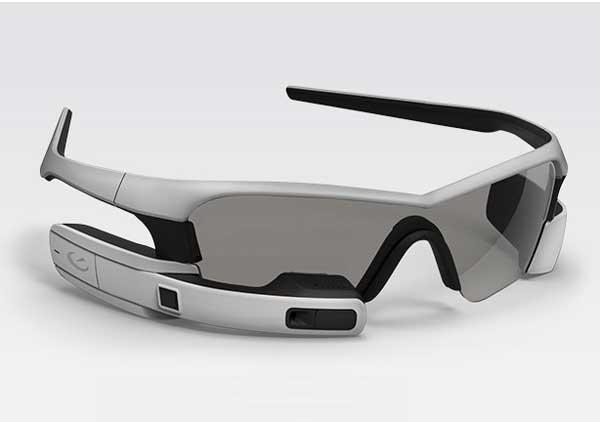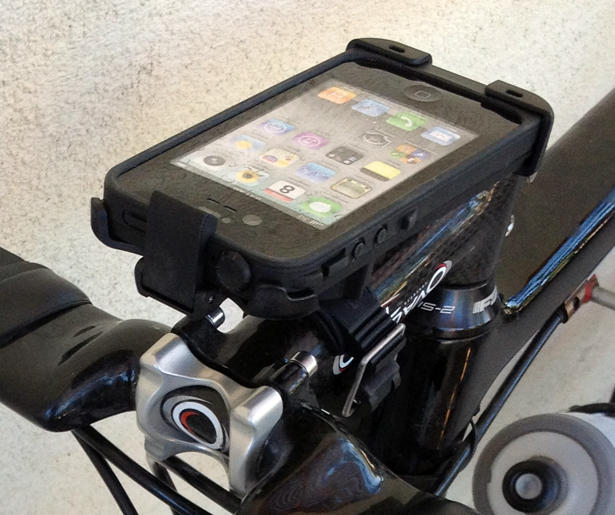Recon Jet
What class of product has most contributed to the speed and success of triathletes over the past 15 years? Improvements in disc and deep race wheels? The aerodynamic benefits and lower weights of newer classes of frames? How about improvements in components, the movement from 9 speeds to 11, and electronic shifting? The comfort of saddles and aerobars?
All these are important. Still, I could not fault the shrewd observer who chooses information as the signature breakout product class of our generation. Power meters, the GPS, and the head units that display this information, lactate analyzers, blood sugar analyzers for diabetics, anything that tells us about us: where we are, what pace we’re keeping, the power we’re producing, the physiological changes in us the effort is generating, this might be the breakout product class.
I flew up to Vancouver, BC, to the headquarters of Recon Instruments. These folks are pursuing a particular motif in wearable computing, the heads-up display, or HUD, and the product is the Recon Jet. The idea is to present information to the user without the need to avert the eyes from the task at hand. This is a technique currently used in aircraft, where diagnostics and metrics are overlaid onto the pilot’s field of vision. Imagine this technique used by a cyclist or triathlete, especially – but not exclusively – while aboard his bicycle.
Obtrusive, you might think. Not necessarily. Right now we watch football on the television and see the first down line superimposed on the screen. We watch swimming and see the line projected in front of (or behind) the swimmer denoting world record pace. HUDs are becoming increasingly available in cars, with metrics projected on windshields. Motorcycle helmets are available with displays laid atop the visor, and an HUD retrofitted to a bicycle helmet was shown at the Interbike trade show almost a decade ago, by a company called Motion Research.
Recon already has a product in the marketplace. It’s a ski goggle or, precisely, a sub-assembly that is built into ski goggles marketed by Oakley, Smith, Uvex, Scott, Briko and others. The tiny display sits on the bottom right of a skier's, or bike rider’s, field of vision, and provides the user the ability to see all his analytics – speed, direction, navigation, vertical drop, jump metrics, altitude in the case of the skier – as well as smartphone connectivity and music. It’s called the MOD Live. That’s for skiing. What about cycling?
Recon Jet
The brain of this product is a 1 GHz dual-core processor, a GB of SDRAM and 8 GB of flash memory. Also somehow shoehorned into this tiny package is a GPS, 3D accelerometer, gyroscope and magnetometer, a pressure sensor for determining elevation and barometry, an HD camera as well as a – currently hibernating, but awaiting functionality – integrated speaker and microphone. And, of course, there’s a battery.
That’s the brain and the internal organs. The eye is an active matrix liquid crystal display (AMLCD) made by Massachusetts-based Kopin. The display is tiny, and rectangular, and has a 6 micron pixel size, which means the display packs a lot of pixels onto a small screen. If we can use pixels-per-inch (PPI) as a gauge for determining sharpness based on pixel density, you’re reading a computer monitor, if you’re at a typical desktop, that has a pixel density of about a hundred PPI. The monitor on a good notebook computer, like a MacBook, displays more than 200 PPI. Your iPhone? More than 300 PPI. The display on the Recon Jet? About 2400 PPI. But that’s what you need if you want to pack enough pixels into a tiny display so that you could watch a movie. We’ll talk more about the applications for a display like this in a moment.
The final technical element to cover in just this brief overview of features is connectivity. The unit has a micro USB port for charging and uploading firmware and apps, but its wireless connectivity is what is interesting, because of the options this brings to a cyclist. The Recon Jet is configured to communicate via both ANT+ and Bluetooth 4.0, and can handle up to 8 ANT devices simultaneously. So, the Jet can display whatever you want displayed from any devices on your bike or your body. Yes, you have the same problem here that you have with your Garmin head unit: so much information that you can’t fit it all on a display. No problem. With the swipe of a finger alongside the unit – next to your ear – you can change the display screen. The unit is quite water and weather resistant and, contrary to the functionality of the typical smartphone, the finger swipe works with gloves on.
The User Experience
This is the first time that Recon has produced an entirely integrated eyewear product. Until now it has either produced a sub-assembly for eyewear makers – ski goggle companies – or it has produced a product that can be fitted to a specially designed goggle made to accept the Recon HUD. The Jet is for cyclists (and runners for that matter, or anyone who wears a sport sunglass), and the look and feel of the glass reminds me a bit of the Oakley Thump, introduced almost a decade ago, the first audio sunglass.
Yes, this is a heavier product than a simple glass, but not obtrusively so. The battery sits on one side, the electronics on the other, and the weight is calibrated to grant balance to the unit, side-to-side and fore-aft. I did not run with the Jet aboard, but I rode on a trainer. The only issue I had was the issue I always have with any glass – Oakley, or any other – sighting through the top rail of the glass, above the lens, while in the aero position. If this bothers you with any glass, it’s going to bother you with the Jet. If this is not really an issue for you, it won’t be for the Jet either. While I did not run in the Jet, I’ve spoken to those who have, no complaints of weight or bouncing. It appears to stay put, as was the case with the Thump.
Yes, the display is crisp. On paper. And for those of you who have pretty good eyesight I suspect it’s going to be very crisp in actual use. I need reading glasses, but if I try to focus on something more than 10 feet in front of me I’m in trouble unless I doff the reading glasses. I had a slight bit of trouble with the display because of the difficulty I have seeing fine details close-up. Mind, I could read the display on the Jet much more easily than I could read the computer screen on which I’m now typing if I did not have on my readers. For reference, I require a reading glass with a magnification of 2.75.
Battery Life
Up to six hours is claimed. The Jet features a retinal sensor that knows when you are looking at it. When your eyes are averted the unit sleeps. When your eyes refocus on the Jet the unit powers up, and does this so quickly that you can’t tell. It’s like trying to view the dark side of the moon. Even if the display is powered down for three-quarters of your ride, you’ll never see it in its sleep mode.
Open Platform
These guys at Recon learned a lesson from Microsoft (Kinect) and Apple (iPhone): if you make a platform – a delivery system, a mule – that mule is going to get a lot more popular if you allow folks just as creative, smart, and clever as you to figure out all the ways to pack it, and to develop applications accordingly. The Recon OS is UNIX-y, and is a souped-up Android OS, and if you can write an Android app you can write apps for the Jet. There is documentation specifically for developers. This product seems to me to be, as far as I can tell, a fair bit ahead of the Google Glass, a product (not yet shipping) in the same general class as the Jet.
Let’s riff off of that open platform theme for a moment. Yes, there’s a camera built into the Jet. Rather than pulling out your iPhone and snapping a pic, you just tap your finger on the Jet and it snaps an HD pic of whatever it is you’re looking at. Or a video. And it’s about on par with a typical iPhone-quality smart phone. In fact, you can configure your Jet to automatically upload any snapped pics to your Facebook (or similar) page, and configure the Jet to display any responses to the Facebook posting on the Jet’s LCD display. If you snap a pic or a video, you can’t directly send that file via the Jet. However, you can configure the Jet so that any image files generated append to the rider’s smart phone. If your phone is sitting on the front of your bike via something like a Lifeproof or Wahoo Fitness mount, you can fairly easily text that image to the intended recipient using the phone’s keypad.
Here’s the thing. You’re connected. So, let’s talk about things just an app away. You could record a ride with your Jet, and then ride that ride again and, like that world record bar on your television screen during a swim event, the Jet could tell you every pedal stroke how far in front or behind that performance you’re riding. Likewise any Strava-style social “race” platform, where entire ride files (not just times) are archived.
The Jet is as powerful as your smart phone, but it can also simply be a slave to your smart phone, displaying the number of the person calling you while you’re riding. You can then choose whether to fish the smart phone out of your jersey pocket. But wait! There’s a mic and speakers built into the Jet. Does this not allow the same functionality to the Jet that I previously wrote about with the Cardo Systems BK-1? Why should I have to take out my phone at all? Why can’t I simply inform Siri to answer the phone, and I’ll have that conversation while riding? The Recon folks demurred a bit when I asked that question. I get the sense that the noise cancellation built into the admittedly larger and more intrusive Cardo is not yet equaled by the Jet. Time, and firmware upgrades, will demonstrate how useful the audio capacity of the Jet.
Yes, we have a camera on board the Jet. How about a camera behind? As I was contemplating the uses for the Jet I wondered if one of its more helpful features might be to see what’s coming up behind you. Remember the rear view Cerevellum Hindsight. Any rear view camera that’s ANT+ or Bluetooth enabled can be used to generate a rear view image on the Jet’s display (you can see this camera image very clearly; one use of this display is as a viewfinder in high-end cameras). No reason why the Jet can’t be configured just like a Cerevellum, to archive a continuous loop, thereby acting as a rider’s black box.
Imagine a rear view image of a vehicle you suspect is driven by a bad behavor. Here’s how the Jet works. You have 3 basic commands. A swipe with your finger on the side of the Jet changes screens, just like moving back and forth a chapter at a time on your Kindle. A tap of the unit communicates a different command. Depressing the unit (like a tap, but firmer) snaps an image with the camera. Depressing the unit for 3 continuous seconds tells the unit to record a video. Another 3sec depression ends the video. You could, then, record the behavior of a driver with a rear view camera and continue recording with the Jet as the vehicle passes you.
Okay, enough spitballing about all the developer options. Slowtwitchers have proven themselves more clever than I at figuring out what to do with the platform the Jet provides.
The Eyewear
How about the glass itself? The eyewear? This is, after all, a sport glass. Recon is not scrimping here. It’s a polarized light smoke. That’s to start with. An Iridium-style lens is also coming, and a clear, and a rose tint, but not initially. These other lenses will come subsequently. The lenses are interchangeable, and retrofittable, and that’s good, because you don’t want to scratch the lens and that that’s the end of the product, and you probably don’t want to buy one of these for all weather conditions.
Price, How to Buy, Availability
This isn’t a product sold through retailers. Not yet. It’s not that Recon is against the retail model, rather that most of their sales, to this point, have been to OEs (selling a sub-assembly to a ski goggle maker). Further, cycling is a new market for Recon, so, no retail relationships (yet). Consequently this launch is consumer-direct. You’ll find a prompt on Recon’s site allowing you to pre-order the Jet. This product is not going to be shipped until December. The price for the Jet is $599. However, the pre-order price is $499. Those who pre-order will be given priority, shipped on a first-come, first-served basis and, of course, enjoy a bit of a discount. The pre-order window begins today and is projected to end on the 21st of July.
Will this product eventually be sold through retailers? Asked them that. Don’t know. These guys are a very high tech company, almost everybody who works there is an electrical engineer or a PhD in physics or math and how to miniaturize and package a high-tech product seems to have been more of a priority, thus far, than devising precisely calibrated sales channel objectives and timelines.
The warranty on the Jet is 1 year. So far, the return rate of the ski goggle product is, according to the company, less than 1 percent, and that's for any kind of return, warranty included.
Future Products
I love the technology and, honestly, while cycling is certainly far, far and way the most salable of markets, the Recon Jet doesn’t give you information previously unavailable to you, it just gives it to you in a heads-up display. Now, swimming, you’re kind of hosed when it comes to information. Here’s what you have available to you in the water: the pool clock, and any audio cues granted by the host of audio options that exist. But no visual cues. This technology makes available the opportunity for visual cues while swimming. Pace. Heart rate. Time. Distance (ever miscount laps in a long time trial in the pool? Ever wonder how far along you are in an open water swim?). Where you are versus a particular pace, or a versus a prior achieved effort, or someone else’s effort. All that is theoretically on the table.
Here it is, the Recon Jet. What's in these sunglasses? Computing power that, a generation ago, would have taken up an entire room.

George Hincapie, wearing his computer.

A Jet is being demo'd by a press member in Recon's headquarters in Vancouver, BC.

This the Recon Jet's brain, not on drugs.

Here's George, JRA with his Jet on board.

Slowman tries them on for size.

Slowman asking impertinent questions and generally causing trouble.

First you develop the functionality. Moderately hard. Then you get it down to a manageable size. That's the tough part.






